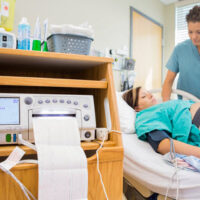In Florida Birth Injury Cases, Does The HELPER Mnemonic Really Help?

If the mother had any prenatal care at all, diligent doctors can easily spot the warning signs of things like shoulder dystocia. This condition is one of the most common causes of birth injuries in Florida. In brief, the baby is too large to travel smoothly through the mother’s birth canal. When that happens and the baby gets stuck, the umbilical cord continues to drop. It will wrap itself around the baby’s neck, causing a serious brain injury within about five minutes.
So, if unexpected shoulder dystocia develops in the delivery room, time is short. Under these conditions, many people, including medical professionals, often make poor decisions. To avoid this outcome, clinicians developed the HELPER mnemonic. However, this catchphrase may not be of much use when it comes to preventing birth injuries.
Call for Help
In many cases, this first step is the most difficult one. Some people are better at asking for help than others. Some people ask for directions when they get lost, and some people just wander around until they find their way.
Unfortunately, many medical professionals fall into that latter category. Many doctors and nurses have an “I’ve got this” mentality. In most cases, that self-confidence is a very good thing. But in birth injury cases, that may not be the case. Furthermore, many professionals view asking for help as a sign of weakness. So, they will do almost anything to avoid making such a call.
Evaluate for Episiotomy
Until recently, many doctors cut the mother’s perineum to widen the birth canal as a matter of course. It did not matter whether the baby was in distress or not.
But recently, several prominent medical associations have advised against this procedure. Cuts of this nature, even if they are very small and shallow, often cause uncontrollable bleeding during delivery. That’s because, between the mother and the baby, there is so much blood in this area in the first place. After delivery, episiotomies often cause intense pain, especially during sexual intercourse.
Since time is so short, many doctors are willing to take risks to safely deliver the baby. Had they been more careful in the runup to the delivery, such risks would not be necessary.
Legs (the McRoberts Maneuver)
Some people believe this step should be higher up. The McRoberts maneuver is successful about 70 percent of the time. The doctor, a nurse, or even a family member elevates the mother’s legs. That position widens the birth canal and often creates enough room for the baby to move down.
A 70 percent success rate means that there is about a 30 percent failure rate. By this time, the five minutes may be down to about three minutes. The pressure is really on as the riskier elements of the HELPER mnemonic come into play.
Suprapubic Pressure and Enter Maneuvers
Partially because time is so short, the next two steps are essentially the same. The doctor uses a CPR-style maneuver just above the baby’s shoulder in an attempt to free it. The “enter maneuver” usually involves pushing the fetus into the pelvis and then trying to rotate it.
These moves are complicated and risky. Newborn fetuses are so small and fragile that any excess pressure can cause a permanent injury. If that pressure occurs near the head or neck, the child will most likely have a brain injury.
Remove the Posterior Arm
By this time, the five minute birth injury clock is approaching zero. Amputation is an extreme measure, especially when the patient is a fetus. However, it is better to go through life with one arm than to struggle with cerebral palsy.
Connect with Tenacious Lawyers
Birth injuries are extremely serious, extremely heartbreaking, and entirely preventable in most cases. For a free consultation with an experienced personal injury attorney in Tampa, contact The Matassini Law Firm, P.A. Home and hospital visits are available.
Resource:
ncbi.nlm.nih.gov/pmc/articles/PMC3100095/
